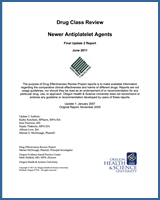NCBI Bookshelf. A service of the National Library of Medicine, National Institutes of Health.
Ketchum K, Peterson K, Thakurta S, et al. Drug Class Review: Newer Antiplatelet Agents: Final Update 2 Report [Internet]. Portland (OR): Oregon Health & Science University; 2011 Jun.
This publication is provided for historical reference only and the information may be out of date.
| Generic name | Trade name | Black box warnings |
|---|---|---|
| Clopidogrel | Plavix® | WARNING: DIMINISHED EFFECTIVENESS IN POOR METABOLIZERS The effectiveness of Plavix is dependent on its activation to an active metabolite by the cytochrome P450 (CYP) system, principally CYP2C19 [see Warnings and Precautions (5.1)]. Plavix at recommended doses forms less of that metabolite and has a smaller effect on platelet function in patients who are CYP2C19 poor metabolizers. Poor metabolizers with acute coronary syndrome or undergoing percutaneous coronary intervention treated with Plavix at recommended doses exhibit higher cardiovascular event rates than do patients with normal CYP2C19 function. Tests are available to identify a patient’s CYP2C19 genotype; these tests can be used as an aid in determining therapeutic strategy [see Clinical Pharmacology (12.5)]. Consider alternative treatment or treatment strategies in patients identified as CYP2C19 poor metabolizers [see Dosage and Administration (2.3)]. |
| Prasugrel | Effient® | WARNING: BLEEDING RISK Effient can cause significant, sometimes fatal, bleeding [see Warnings and Precautions (5.1 and 5.2) and Adverse Reactions (6.1)]. Do not use Effient in patients with active pathological bleeding or a history of transient ischemic attack or stroke [see Contraindications (4.1 and 4.2)]. In patients ≥ 75 years of age, Effient is generally not recommended, because of the increased risk of fatal and intracranial bleeding and uncertain benefit, except in high-risk situations (patients with diabetes or a history of prior MI) where its effect appears to be greater and its use may be considered [see Use in Specific Populations (8.5)]. Do not start Effient in patients likely to undergo urgent coronary artery bypass graft surgery (CABG). When possible, discontinue Effient at least 7 days prior to any surgery. Additional risk factors for bleeding include:
|
| Ticlopidine | Generic only | Warning Ticlopidine hydrochloride can cause life-threatening hematological adverse reactions, including neutropenia/agranulocytosis and thrombotic thrombocytopenic purpura (TTP) Neutropenia/Agranulocytosis Among 2048 patients in clinical trials, there were 50 cases (2.4%) of neutropenia (less than 1200 neutrophils/mm3), and the neutrophil count was below 450/mm3 in 17 of these patients (0.8% of the total population). TTP One case of thrombotic thrombocytopenic purpura was reported during clinical trials. Based on postmarketing data, US physicians reported about 100 cases between 1992 and 1997. Based on an estimated patient exposure of 2 million to 4 million, and assuming an event reporting rate of 10% (the true rate is not known), the incidence of ticlopidine-associated TTP may be as high as one case in every 2000 to 4000 patients exposed. Monitoring of clinical and hematological status Severe hematological adverse reactions may occur within a few days of the start of therapy. The incidence of TTP peaks after about 3 to 4 weeks of therapy and neutropenia peaks at approximately 4 to 6 weeks with both declining thereafter. Only a few cases have arisen after more than 3 months of treatment. Hematological reactions cannot be reliably predicted by any identified demographic or clinical characteristics. During the first 3 months of treatment, patients receiving ticlopidine hydrochloride must therefore be hematologically and clinically monitored for evidence of neutropenia or TTP. If any such evidence is seen, ticlopidine hydrochloride must be immediately discontinued. The detection and treatment of ticlopidine-associated hematological adverse reactions are further described under WARNINGS. |
References
- 1.
- Sanofi Aventis US. Plavix product label. [Accessed May 25, 2011]. http://www
.accessdata .fda.gov/drugsatfda_docs /label/2011/020839s051lbl.pdf . - 2.
- Eli Lilly and Co. Effient product label. [Accessed May 25, 2011]. http://www
.accessdata .fda.gov/drugsatfda_docs /label/2010/022307s002lbl.pdf . - 3.
- Ticlopidine hydrochloride product label. [Accessed May 25, 2011]. http://www
.accessdata .fda.gov/drugsatfda_docs /anda/99/75161_Ticlopidine %20Hydrochloride_Prntlbl.pdf .
- Boxed warnings for included drugs - Drug Class Review: Newer Antiplatelet AgentsBoxed warnings for included drugs - Drug Class Review: Newer Antiplatelet Agents
Your browsing activity is empty.
Activity recording is turned off.
See more...
